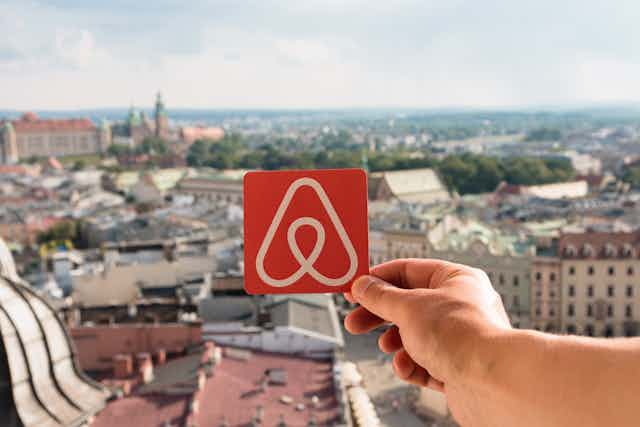The Airbnb and empty house phenomena and their presumed links to housing and rental prices have attracted considerable media and political attention. The ABC points to the “dark side” of Airbnb and its effect on long-term rental prices. Empty houses are being linked to higher housing prices and to foreign investment, most often Chinese investment. The Australian headlines that “China buyers raise ghost town fears”.
The Commonwealth and state governments are seeking to regulate the phenomena. It is questionable whether they should and even whether they understand the data and trends.
Further reading: How Airbnb is reshaping our cities
The Airbnb question
Airbnb involves renting an entire home, a room or a shared room. Short-term rental of an entire house or flat that is available all year is equivalent to reducing long-term rental options.
Airbnb poses a possible threat to rental affordability. The income Airbnb generates in areas of cities popular with tourists causes owners of rental properties to withdraw these from the long-term rental market. It also causes investors to acquire property and enter the Airbnb market, and to increase the cost of long-term rental.
This may create a ripple effect as relatively high-income households are displaced to adjacent neighbourhoods. The scale of Airbnb impacts on rents, displacement of long-term renters and neighbourhood fragmentation has led cities such as Barcelona, New York and Amsterdam to attempt to ban, or strictly regulate, the extent and location of Airbnb.
Should similar effects be anticipated in parts of Australian cities that are popular with tourists? Data on Airbnb accommodation in Melbourne and Sydney as of December 2016 are:
Melbourne: 12,174 listings, of which 57% are for entire homes
Sydney: 24,078 listings, of which 61% are for entire homes.
The number of Airbnb properties potentially removed from Sydney’s permanent rental market with an average vacancy rate of around 3% amounts to approximately half of the available rental properties.
The scale of the Airbnb phenomenon is increasing. So, too, is the company’s influence, with its membership of the Committee for Sydney and its status as a source of Qantas Frequent Flyer points.
Government may well have to consider regulating Airbnb. The question is whether Airbnb is best managed by state government, or metropolitan or local government.
For example, the Victorian government has designated the Melbourne suburbs of Fitzroy and St Kilda for Airbnb development. Why should this be a state decision? Might the residents of already costly rental Fitzroy and St Kilda have their own views?
The empty housing question
On the night of the 2016 Census, 1,089,165 dwellings were empty – 11.2% of all Australian dwellings. It’s widely assumed that these empty dwellings, by not contributing to housing supply, increase house prices.
Supposing that this is the case and presuming that foreign investors contribute significantly to the empty house phenomenon, the Australian government’s 2017-18 budget introduced a levy on foreign investors who leave properties vacant for more than six months.
Not solely blaming foreign investors and also looking at domestic speculative investment, the State of Victoria has introduced a vacant residential property tax. This “is intended to encourage these owners to make their property available for purchase or rent … [but] will only apply to vacant properties located in the inner and middle suburbs of Melbourne”.
However, empty house data should be seen in context: over the previous 35 years, between 9.2% and 11.2% of houses were empty. Vacancy rates have changed little over this time. Almost two-thirds of empty dwellings on census night are holiday houses or dwellings where owners were absent. Among the capital cities, only in metropolitan Perth did the empty dwelling rate exceed 10%.
SGS Economics and Planning estimates about 110,000 of the vacant dwellings – 10.6% of the total – were available for short and long-term rental. This small proportion available for rent, amounting to 1.2% of Australia’s houses, would probably not attract media and political attention.
Further reading: Taxing empty homes: a step towards affordable housing, but much more can be done
Nonetheless, foreign investment in housing is a global phenomenon that focuses on specific cities, such as Vancouver, New York, Miami, London, Paris, Auckland and Sydney. Blaming foreign investors for its 107,000 empty dwellings, the Parisian government “tripled the current 20% extra that non-resident owners have to pay in council tax, or taxe d’habitation, to 60%”. Vancouver imposed a 15% tax on foreign investment in housing. Following this, “the number of foreign buyers dropped by 80%. That helped dampen house-price inflation there but pushed up demand in nearby Victoria.”
What level of government should manage these issues?
It is unclear whether Sydney and Melbourne will come to have a level of empty dwellings that warrants federal and state attention. Should this be required, the question is which tier of government can best manage the phenomenon.
It is difficult to argue that taxes should be applied at federal and state levels because foreign investment, property speculation and Airbnb affect some cities and not others. They affect some suburbs and not others.
For example, due in part to “a soft residential property market” and “lower land values”, tax revenue for Western Australia is in its third year of decline. The state government and Perth homeowners might welcome foreign investment and Airbnb to sustain tax revenue and house prices.
Would a metropolitan government, learning from metropolitan interventions elsewhere, not be better placed to manage the effects of Airbnb and empty houses?
Cities around the world are seeking to manage these phenomena and sharing experiences of how best to do this. In Australia, though, the Commonwealth and state governments presume to know best.

